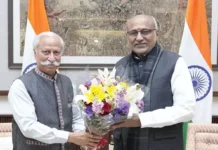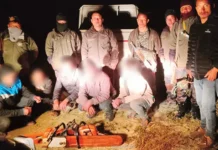[ Umesh Srinivasan, Nandini Velho,
Lobsang Tashi Thungon and Anthony Tallo ]
Arjun Tsering Phinya dangles several feet above the ground, his waist harness clipped to a rope, the rope looping around the branch of a tamarind tree. Arjun is a 26 year old member of the Bugun community, a small tribe that lives in the West Kameng district of Arunachal Pradesh. And to be dangling from a tamarind tree-that does not grow in West Kameng-Arjun has to be a long way from home.
He is. Arjun is one of eight Bugun youth from Singchung village, who have been appointed as anti-poaching staff of the Singchung Bugun Village Community Reserve (SBVCR), a groundbreaking conservation initiative.
In February of 2017, the Singchung Village Council (SVC) voluntarily partnered with the Arunachal Pradesh Forest Department to create the SBVCR, formally protecting a major portion of their traditional lands for conservation.
Their lands are the only place in the world where the critically endangered and newly discovered bird species, the Bugun Liocichla, is found so far. The Bugun Liocichla was discovered only in 2006, and named in honour of the wildlife and habitat conservation efforts of the Bugun tribe. While bird watching tourists from around the world visit this area every year, a mechanism of formally protecting this area has now tried to ensure further safeguards, and greater sustainability in conservation.
This community reserve is not only a gift to the world and future generations, given its rich biodiversity, it is also leading the way in the rigorous management that is being put together in the background.
Especially important has been the extraordinary support and involvement of the Shergaon Forest Division, and its inspirational Divisional Forest Officer (DFO), Millo Tasser. From the very start, Millo Tasser has been at the forefront of organising meetings and workshops with the Bugun community of Singchung village. He spearheaded one of the first meetings back in 2013, where he created a platform for all stakeholders to discuss the importance of the community reserve, especially in terms of its irreplaceable biodiversity and watershed values for the residents of Singchung. During the formal process of mapping the community reserve, which started in May 2016, he joined a team of scientists and Singchung residents, and trekked through forests and fields to map and rationalise the boundaries of the SBVCR.
Not content with just a formal declaration of the reserve, there have been rapid and comprehensive strides towards the effective conservation of the SBVCR. Arjun is one of two of the eight SBVCR staff that Millo Tasser arranged for to be trained in snake handling and rescue at The Gerry Martin Project field station in Hunsur, Karnataka. Now a trained handler and rescuer of venomous snakes-the monocellate cobra is the commonest species to enter houses in Singchung-he’s not sure anymore which is more dangerous, rescuing a snake, or hanging tens of feet above solid ground from a rope. Although he’s quick to point out that the first rule of snake handling is to always respect the snake, and to never convert a snake rescue into macho showboating for the public.
Millo Tasser has innovatively harnessed their training to advance outreach on the ground, with one of the most innovative Independence Day celebrations this year, with a focus on wildlife. Millo Tasser helped Arjun and his Bugun colleagues to put together a remarkable event for their hometown, in which they led a detailed snake myth-busting session, and demonstrated first aid measures in the case of snakebite. They have already begun to rescue snakes that have been entering houses this monsoon season. But snakes are not the only things on the minds of the Community Reserve staff.
At the same celebration, Millo Tasser personally lent Rs 40,000 to the SBVCR team, who ordered community reserve-related merchandise (coffee mugs, postcards, saplings) to sell at the Independence Day stall, which was inaugurated by the local MLA. Their stall was a huge hit. Not only did they raise enough money to pay back what they had borrowed, they also made a tidy profit of Rs 25,000 – all of which goes to the staff welfare fund of the community reserve. The excitement and ownership is such that the staff have decided to put aside half their salaries-entirely on their own initiative-to buy motorcycles for more effective patrolling. And together with Millo Tasser they are innovating in other ways.
This includes other concrete measures, such as getting people on the ground for patrolling. Not only was there a process to formally interview residents for patrolling, that the DFO headed, staff are now being trained in a systematic manner.
In August, 2017 all eight members of the squad spent almost a week at Lama Camp, the flagship eco-tourism campsite of the sustainable conservation initiative of the Bugun tribe. The agenda was clear – to receive state-of-the art training in frontline anti-poaching and patrolling. The schedule was unforgiving – morning and evening drills and exercises, long treks, training in unarmed combat, camouflage, ambush, first aid, use of compasses and GPS for navigation, night patrolling, useful knots, rock-climbing and a bewildering host of other vital field skills. The training team from WWF-India was spearheaded by an officer of the Special Task Force of the Tamil Nadu Police Department, a unit that specialises in jungle combing operations. WWF-India also trained the staff in bird watching and wildlife monitoring, a shot in the arm for the existing wildlife-based eco-tourism program already in place.
The results are crystal clear – a sense of price and ownership emanates from the squad, and the confidence is contagious. The staff is already on the job. They have prevented the ecologically damaging practice of boulder extraction in the Community Reserve, a practice that makes landslides more frequent and much more devastating.
Not only have we been able to witness this real-time change, we have never seen such efforts in our last decade of work around Eaglenest. These remarkable and exemplary conservation gains have been built by the DFO on a solid bedrock of unstinting support that has been put together by his highly effective and motivated team of individuals and organisations. He has, with his down-to-earth outlook and respect for local law and customs, won the support of the SVC, and indeed, the strong conservation ethos of the Bugun community of Singchung is the foundation for the work to date, and for future work.
He has also brought together a diverse group of people and institutions to make ranger trainings possible, and continues to take a personal interest in the working and development of the reserve staff. The Rainforest Trust, in partnership with the Centre for Wildlife Studies in Bangalore has committed to provide financial and administrative support, enabling employment, training and state-of-the-art equipment for the initial stages of setting things up in the SBVCR. His leadership and presence on the ground has instilled a deep sense of determination to try and make the community reserve a model conservation program.
The Singchung Bugun Village Community Reserve is a one-of-a-kind initiative, one that can serve as an archetype for effective conservation not only for Arunachal Pradesh and northeast India, but for community-based conservation that can safeguard India’s rich biodiversity outside protected areas.
Millo Tasser and his amazing team of individuals and institutions will be key in guiding the trajectory of this program in the future years to ensure its lasting success for Arjun, the Bugun community of Singchung and their spectacular biodiversity. Onward and upward! (The authors have been associated and worked in and around Eaglenest Wildlife Sanctuary)



